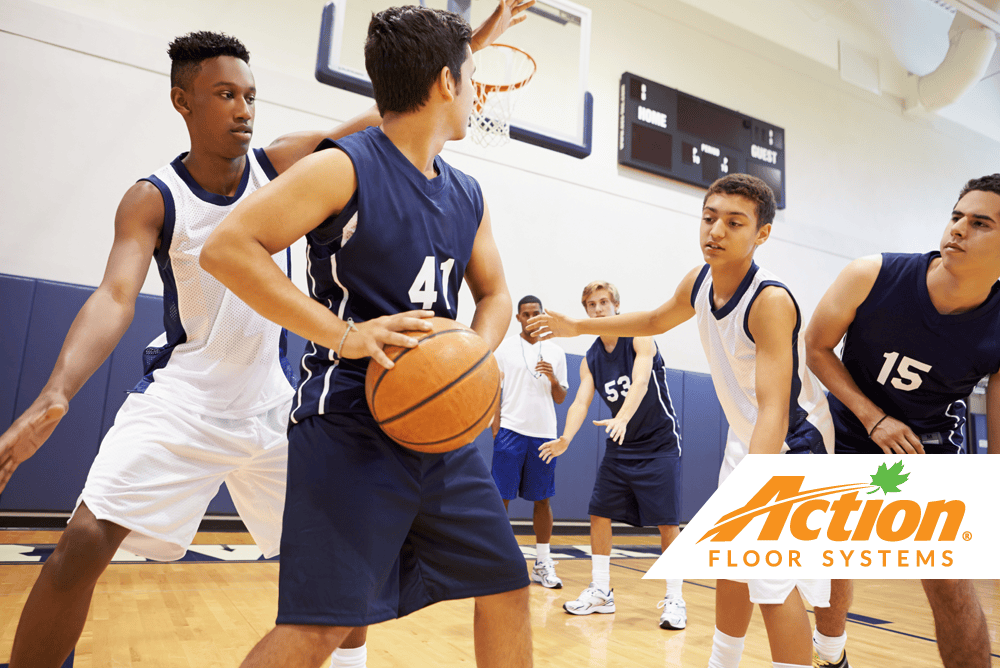
Before you decide on the right sports surface for a school or other type of athletic facility, you need to have a foundational understanding of the different types of floor systems, how they perform, and when you may want to choose one over the other.
There are a variety of performance attributes of sports floor systems, and these characteristics are defined and laboratory tested using the standards detailed in ASTM F2772. Before diving into performance features, however, it’s important to begin with a knowledge of the three categories of sports floor systems: area elastic, point elastic, and mixed or combined elastic.
So, what’s the difference? Let’s take a closer look so you can contribute to conversations about what will work best in your facility.
Area Elastic Sports Floor Systems
Resilient hardwood maple sports floors that include a subfloor system are considered area elastic.
This category of sports flooring provides athletes with what is known as area deflection, which measures how energy produced by movements like running, jumping, or bouncing a ball gets dispersed through the floor.
Aset Services, a trusted third-party testing service for the sports flooring industry, describes area deflection this way …
“Area deflection is a measurement of how well the sport surface transmits vibrations generated from an impact through the surface. A higher value for area deflection means vibrations are transmitted stronger and further within the system. If you have ever dribbled a basketball and felt the floor vibrate beneath your feet, that essentially is what area deflection measures. Lower values mean the vibrations are smaller and you don’t feel them as much. Higher values often feel uncomfortable to the athlete.”
Choosing a system with the right amount of area deflection for your hardwood courts may depend on the preferences of athletes and coaches. Area elastic floors are known for providing a high level of shock absorption for athlete comfort and safety.
Point Elastic Sports Floor Systems
Most synthetic sports floor systems, including polyurethane pad and pour floors, such as the Action Herculan® line, are considered point elastic.
Point elastic sports flooring is not tested for area deflection. The system is typically attached directly to the concrete slab, keeping energy from player movement and ball bounce localized. Point elastic sports floors, however, can still provide shock absorption when a rubber mat is used as part of the system.
Here’s how Action Floor System’s Director of Synthetic Sales Cory Corullo describes the difference between point and area elastic …
“A helpful way to explain it is the difference between stepping on a sandy beach versus a trampoline. Point elastic floors are like sand because the movement only occurs close to where you step. But with a trampoline, the energy travels across the entire surface.”
While there may be comparatively less force reduction than area elastic floors, a benefit of point elastic floor systems is uniformity of play. Athletes will experience the same levels of shock absorption and ball bounce across the court.
Mixed Elastic Sports Floor Systems
Also known as combined or combi-elastic sports flooring, this category is literally a combination of point and area elastic floors because it uses a synthetic surface with wood subfloor features.
A mixed elastic option is essentially a point elastic system with area elastic properties. That’s because a point elastic surface is being supported by an engineered subfloor. Action Floors can provide subfloor systems manufactured from plywood or hardwood premium sheathing (HPS).
A mixed elastic sports floor system allows a facility to achieve greater shock absorption while experiencing the benefits of durability, ease-of-maintenance, and alternative design options that come with a quality polyurethane sports floor. However, most high schools and colleges prefer a resilient hardwood court for competitive play.
What’s Right for Your Facility?
It’s worth taking the time to fully understand the many aspects of a good sports floor. This is an investment in your facility that should last many years, so getting honest answers is important.
Check out our Case Studies section to see how schools and other facilities found a system for success with Action Floors.
If you have questions about selecting sports flooring, want to know more about the differences between point, area, and mixed elastic floors, or need additional information about your options, contact Action Floors today.
We’re happy to assist you and point you in the direction of the right sports flooring expert.


















